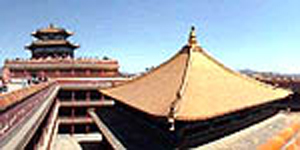| Legole.Com Discover china. Explore the beauty and wonder of the land, people, and culture of China. |
 |
|
|
 |
 Personally speaking, I'm not a person who likes to pay much attention to the temple architectures. But after knowing well about the Eight Outer Temples, I have changed my mind. I'm so deeply impressed by their special cultural backgrounds and priceless architectural talents. So for the first time, I'd like to introduce the temples to you. Personally speaking, I'm not a person who likes to pay much attention to the temple architectures. But after knowing well about the Eight Outer Temples, I have changed my mind. I'm so deeply impressed by their special cultural backgrounds and priceless architectural talents. So for the first time, I'd like to introduce the temples to you.
Outside the Summer Resort of Chengde, there are twelve temples built during the Qing Dynasty (1644~1911). Dominated by eight districts at that time, they were called the Eight Outer Temples. It took 67 years to build these temples. Standing for the different architectural style of various Minorities in China, the Eight Outer Temples is the symbol of the country's unity and minorities' solidification. Till now, there are seven temples left.
The architectures in the Eight Outer Temples are Tibet style, Han Nationality style, Han and Tibet combination styles. Examples are Putuo Zongcheng Temple, Xumi Fushou Temple, Puning Temple and Pule Temple.
Putuo Zongcheng Temple - A small Potala Palace
Built in 1771, the Putuo Zongcheng Temple is a most resplendent and sweeping one. It covers an area of 220,000 square meters, and is similar to the Potala Palace in Lhasa. This temple was built for celebrating the emperor Qianlong's birthday. Zang-style architectures are displayed thoroughly there. A square architecture named Big Red Platform is the principal part, on which there are three halls. The tops of the halls are covered with the copper gold tiles, thus a very precious monument. This temple was used to hold important religion ceremonies and for the emperors to interview the heads of the Minorities and some ministers in the past.
Xumi Fushou Temple
This temple was built for the sixth Panchen Lama (head of Tibet) in 1780. Because on Aug. 13, 1780 was the Emperor Qianlong's seventieth birthday. In order to celebrate it, the master spent one year from Tibet to Chengde. Then Qianlong ordered to build a temple for him to rest and sermonize. The name "Xumi Fushou Temple" means blessing and longevity. It's the combination of Han and Tibet architectural styles. Also a big red platform is very noticeable. On the tops of the palaces, there are eight copper gold dragons, refined and lively. Inside a palace, Sakyamuni is oblate there. Seen from the distance, the temple exudes in impressiveness and magnificence.
Puning Temple - A Great Buddha Temple
The world's largest woodcarving Buddha is in this temple. Different from other Buddhas, it has thousands of hands and eyes, 22.28 meters high and 15 meters wide. It is made from the materials of pine, cypress, elm, fir and basswood. Inside the temple, there are Bell and Drum Towers, Pavilions, Heaven King Palace and Daxiong Baodian. Built in 1755, the temple shows the Qing Dynasty's respect to the Minorities.
Pule Temple
The Pule Temple is just like a round pavilion from the appearance. And also some people say it is really another Temple of Heaven. Entering the temple, you will find most of the things built with wood blocks called Stramonium. There are 72 woods symbolizing 72 kinds of wisdom of the Buddha.
However, when you get to the Eight Outer Temples of Chengde, you seem to enter a Buddhas' country. Delicate architectures and profound cultures will leave you a memorable tour.
Scenic Spots Admission Fee
(RMB) Recommended Time
for A Visit
Puning Temple 50 Two to four hours
Putuo Zongcheng Temple 40 Two to four hours
Xumi Fushou Temple 30 Two hours
Pule Temple: 30 Two hours
Anyuan Temple 10 One to two hours
Opening Times: 8:00 am - 17:30 pm |
 |
|
|
 |
|
